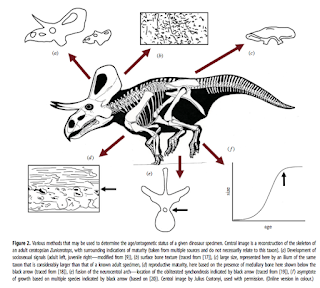However, telling what age it is can be difficult, and in fact, different methods can give different signals. This question was addressed in a new study by Hone et al. (2016), using dinosaurs as an example. So how do you tell what ontogenetic (age-class) stage the fossil in question is from? There are a number of different methods we can use, some of which are described in this paper. At first glance, relative age can often be determined if there are any structures present that are typical of sexual display structures (i.e. crests, horns, and frills). The more developed these are, the older the animal is. Relative size is also often a good indicator - chances are the larger individuals of a species are going to be older than the smaller one, without other features indicating sexual dimorphism, sexual immaturity, etc. Fusion of elements can also be used, such as relative fusion of skull bones or the neural arch of vertebrae since fusion of bone typically occurs later on in an animal's life, when the animal is no longer growing rapidly. Rapid growth can also be looked at in detail through histological sampling of bone tissue, and general bone texture can also give an idea of the relative age of the fossil.
 |
| From Hone et al. 2016 |
But what happens if you have a species that appears to be osteologically or skeletally immature - it has unfused bones or is still rapidly growing - but has a well developed crest and is of large size? This brings in another issue all together - the difference between skeletal maturity and reproductive maturity. Hone et al. (2016) suggest that in palaeontology, we tend to under-age our material. Non-avian dinosaurs were typically described as juvenile or sub-adult when they may have in fact been sexually mature. In the modern world, we consider animals to be adults when they reach sexual maturity (aside from our own species, which we make up our own rules for). A dinosaur can be a sexually mature adult before attaining all of the features that define its species.
Hone et al. (2016) suggest that when trying to age a fossil, overlapping criteria is needed. In order to be sure of your identification, use as many of the ageing techniques as possible. This is not a surprise, nor is it particularly new as science works best when you get the same answer using different methods. However, this is particularly difficult in palaeontology. The specimen may be particularly incomplete or poorly preserved, making things like size, sexual features, or bone fusion difficult to determine. Or, this may be the only specimen you have of that species, which makes determining relative size compared to others impossible.
Even with these problems, it's true that we do probably need to do better at our definitions. There are a number of definitions of growth stages out there, and they are a bit 'wish-washy' sometimes. They also suggest re-defining the words "adult", "subadult", "juvenile" and "embryo" when it comes to dinosaurs, creating a new standard going forward. Unfortunately though, we are as good as our samples, and there isn't a whole lot we can do about the state of the fossils we find!
Reference:
Hone, DWE, Farke, AA, and Wedel, MJ. 2016. Ontogeny and the fossil record: what, if anything, is an adult dinosaur? Biology Letters 12: 20150947.